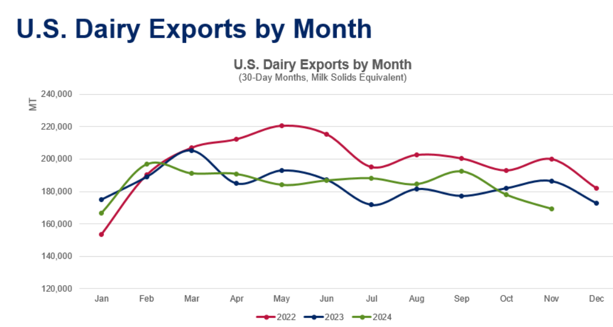U.S. Dairy Exports Falter Amid Volatility, Cheese Shines in Latin America Declines in U.S. Dairy Exports Mark a Shaky Q4 Start

Global demand for dairy eased in November as the UN Food and Agriculture Organization’s Food Price Index reflected the highest dairy commodity prices in over a year. Elevated prices created headwinds for major exporters. While EU27 data was unavailable at press time, New Zealand also reported a drop in dairy export volumes for the month.

Cheese and Butterfat Drive Bright Spots Amid Declines
Despite the overall decline, U.S. cheese exports remained a standout performer, marking their 11th consecutive YOY increase in November (+2%, +928 MT). Although this represented the smallest YOY cheese growth for the year, the 39,503 MT exported in November was consistent with the average monthly volume from the previous five months (40,197 MT). Growth in cheese exports was led by Latin America: Central America (+26%, +1,049 MT), Mexico (+6%, +951 MT), South America (+17%, +290 MT), and the Caribbean (+6%, +141 MT). However, shipments to South Korea, China, and the UAE fell.
U.S. butterfat exports soared in November (+126%, +2,479 MT), with a significant 131% rise (+1,658 MT) in shipments to Canada, fueled by a favorable price gap between U.S. products and those from the EU and New Zealand.
NFDM/SMP and Whey Exports Struggle
On the downside, NFDM/SMP exports declined YOY to nearly all major buyers: Southeast Asia (-43%, -9,325 MT), Mexico (-6%, -2,767 MT), South America (-28%, -1,148 MT), and the Middle East/North Africa (-34%, -748 MT). Low-protein whey exports also fell, driven largely by a 24% drop (-5,345 MT) in shipments to China, the top market for U.S. whey.
Dairy Export Value Remains Resilient
Despite declining volumes, U.S. dairy export value in November rose 10% to $691.5 million, buoyed by higher dairy commodity prices and stronger sales of higher-value products like cheese and high-protein whey. YTD U.S. dairy export value through November increased by 2%, reaching $7.62 billion.
Global Outlook and Price Trends
Dairy commodity prices eased slightly in December, providing hope for a stronger finish to 2024. The first Global Dairy Trade auction of 2025, held on January 7, showed further price declines for New Zealand products, potentially signaling improved competitiveness for U.S. exports.
Cheese Exports to Central America and Caribbean Surge
Cheese exports have been a bright spot for the U.S. dairy industry, with Latin American markets leading the charge. In November, U.S. cheese shipments to Central America and the Caribbean reached a record 7,556 MT, a 19% increase YOY. These regions consistently outperformed prior-year levels in 2024, with YTD cheese exports up 18% (+12,391 MT).
Countries like Guatemala (+16% YOY, +300 MT), Panama (+39%, +270 MT), and El Salvador (+105%, +221 MT) were top performers. Rising incomes, improved economic conditions, and the expansion of U.S. foodservice outlets underpinned demand. However, potential risks include reduced remittance flows, which accounted for 11.8% of GDP in Central America and 9.2% in the Caribbean in 2024. A slowdown in these capital inflows could dampen economic growth and cheese demand.
Challenges in Low-Protein Whey Exports to China
The decline in U.S. low-protein whey exports in November was primarily driven by weaker demand from China. Shipments of permeate (-36%, -3,122 MT), dry whey (-21%, -1,456 MT), and low-protein whey protein concentrates (-12%, -765 MT) all fell.
Traditionally, low-protein whey products are used extensively in China’s swine sector for piglet feed. While the economics of China’s pork industry have improved, higher U.S. prices for dry whey compared to European counterparts likely drove Chinese buyers to seek cheaper alternatives. Additionally, potential misclassification of low-protein products under incorrect tariff lines may have contributed to artificially low export figures. For instance, in November, high-protein whey prices to China were significantly lower than to other destinations, suggesting possible data anomalies.












